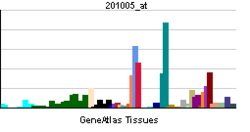CD9
CD9 antigen is a protein that in humans is encoded by the CD9 gene.
The protein encoded by this gene is a member of the transmembrane 4 superfamily, also known as the tetraspanin family. Most of these members are cell-surface proteins that are characterized by the presence of four hydrophobic domains. The proteins mediate signal transduction events that play a role in the regulation of cell development, activation, growth and motility.
CD9 is a cell surface glycoprotein that is known to complex with integrins and other transmembrane 4 superfamily proteins. CD9 is found on the surface of exosomes and it can modulate cell adhesion and migration and also trigger platelet activation and aggregation. In addition, the protein appears to promote muscle cell fusion and support myotube maintenance. This protein also seems to be a key part in the egg-sperm fusion during mammalian fertilization. While oocytes are ovulated, CD9-deficient oocytes are not properly fused with sperm upon fertilization. CD9 is located in the microvillar membrane of the oocytes and also appears to intervene in maintaining the normal shape of oocyte microvilli.
...
Wikipedia

